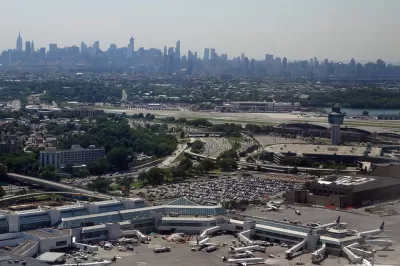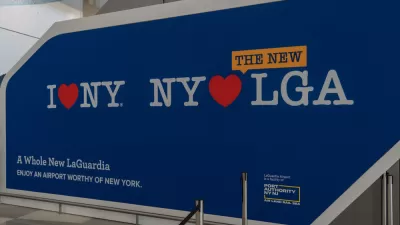It may be too late to pivot on the recently announced rebuilding of New York City's LaGuardia Airport, but Jim Venturi has some ideas about how New York can solve two critical problems—one infrastructural, one humanitarian—at the same time.

To many air travelers, New York's LaGuardia Airport feels like a prison. It suffers notorious delays, is difficult to get to, and, according to surveys, is as unpleasant as airports get. But most LaGuardia customers can only imagine what goes on a few hundred meters outside of LaGuardia's boundaries at the city's Rikers Island prison complex.
This week federal, city, and state officials announced that LaGuardia would be torn down and replaced with a brand-new terminal, to the tune of $4 billion. Writing for The Architect's Newspaper, Jim Venturi argues that the redesign of LaGuardia should think bigger: it should also include the demolition of Rikers.
Rikers' ten jails house between 12,000 and 15,000 prisoners in any given day. Many of these jails are in ghastly shape, with abuse and mismanagement fairly well documented. Venturi proposes that Rikers' jails be relocated and spread out among the five boroughs, in part to make them more accessible and therefore more human. "Any jail on an island will be toxic," writes Venturi. In Rikers' place, Venturi proposes that LaGuardia absorb the island (via landfill) and replace it with a vast runway complex that could make it "the world's leading airport....By adding this infrastructure and increasing airport capacity, we would gain a significant opportunity to expand New York City’s economy beyond Manhattan."
Not only that, Venturi has a plan for transportation to the airport, proposing a new train station in the Bronx that would take pressure off Manhattan's notorious Penn Station and serve as a high-capacity transfer point for the new LaGuardia.
FULL STORY: Comment: Instead of closing LaGuardia, let's fix it and close Rikers

Alabama: Trump Terminates Settlements for Black Communities Harmed By Raw Sewage
Trump deemed the landmark civil rights agreement “illegal DEI and environmental justice policy.”

Planetizen Federal Action Tracker
A weekly monitor of how Trump’s orders and actions are impacting planners and planning in America.

Why Should We Subsidize Public Transportation?
Many public transit agencies face financial stress due to rising costs, declining fare revenue, and declining subsidies. Transit advocates must provide a strong business case for increasing public transit funding.

Understanding Road Diets
An explainer from Momentum highlights the advantages of reducing vehicle lanes in favor of more bike, transit, and pedestrian infrastructure.

New California Law Regulates Warehouse Pollution
A new law tightens building and emissions regulations for large distribution warehouses to mitigate air pollution and traffic in surrounding communities.

Phoenix Announces Opening Date for Light Rail Extension
The South Central extension will connect South Phoenix to downtown and other major hubs starting on June 7.
Urban Design for Planners 1: Software Tools
This six-course series explores essential urban design concepts using open source software and equips planners with the tools they need to participate fully in the urban design process.
Planning for Universal Design
Learn the tools for implementing Universal Design in planning regulations.
Caltrans
Smith Gee Studio
Institute for Housing and Urban Development Studies (IHS)
City of Grandview
Harvard GSD Executive Education
Toledo-Lucas County Plan Commissions
Salt Lake City
NYU Wagner Graduate School of Public Service



























